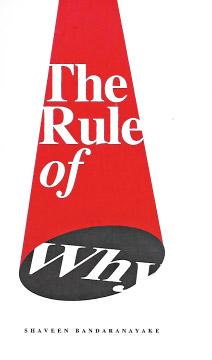
We know what is Rule of Law? But, have we heard the expression, “The Rule of Why”? Well, we shall find out from a little booklet of 56 pages written by a multi-qualified author, Shaveen Bandaranayke. It is published by Sarasavi Publishers and is priced at Rs 225/-
What in a nutshell, is the book saying, in this collection of informative essays? It is made easy in the blurb in the back cover.
“The Rule of Why is a contemporary look at the nuances of modern advertising amid an increasingly information abundant world, with the advent of social media. It is a theory of a post-traditional media landscape – a marketing and communications world in which the message is:
(a) no longer just originates from the brand
(b) no longer unidirectional and unquestionable by the audience.
He adds:
“The author considers the notion that, consumers are far more aware of their purchase decisions than brands assume and that the only way to convince the consumer of their brands worth over the other, is to ‘show them’ that which they would otherwise never know.”
This book, as the author acknowledges is a look at the post-Ogilvy world of advertising.
To understand and appreciate what he says, we must know something about his impressive credentials. He has collected his degrees from foreign Universities. B A Hons, M A Film, LL. B Hons and had had a 6-year career in advertising and strategic marketing efforts. In Sri Lanka, he had an advertising agency in 2011 called Asenshal. We gather he had also been a filmmaker.
Having known his potentiality, we shall try to look at his contemporary view on Advertising.
There are eight brief chapters such as, What, Why, How, Where, Who, When, (which I like) and Conditions Apply and Case Study.
Let me excerpt some of his statements from each of his subjects to show what he is trying to argue for a better understanding, if someone queries about his convictions.
What
“Every advertisement should accomplish this feat (please read the previous paragraphs in the book) and every advertisement, I argue, can. Ask any filmmaker on what the most important thing in a film is and they won’t hesitate to tell you that it is the story. An audience will forgive every technical detail in the world, as long as you tell them a ‘different’ story. An audience wants to live in a story they’ve never experienced before. The same is true for advertising.” “An advertisement is as much a story as it is a dissemination of information to the audience.” “This book aims to identify two indelible things. First, why now more than ever, brands have to focus on communicating their story; the portent ‘why’. Second, how to incorporate this thinking into any campaign conducted – a ‘how-to guide to speak.”
Why
“But, for brevity’s sake, let’s presume two distinct periods of advertising, made up of one singular turning point- social media. But, before the boom of social media, advertising took on a unidirectional form.”
How
“A brief is a communique and it is not only to educate the adman of your intention as marketer but also provide an avenue for the adman to gauge who YOU are. I would argue, the question that has to be asked at every boardroom when formulating a brief and at every briefing conducted in the presence of an agency is, “Why are we doing, what we are doing?”
Where
“The post-social media boom has forced brands to ‘join’ conversations rather than create them. However, what is fascinating is how marketeers and admen alike, have tried and failed to adopt traditional campaigns for online consumption.”
Who
“A number of brands and marketeers have become accustomed to attaching themselves to an individual or a persona in order to leverage their own presence and by extension their ideals. This, personality is, on a grander scale referred to as a ‘brand ambassador ‘or at times as merely an endorser.”
When
‘Conversely however, digital platforms thrive on its ability to go further and target not only based on age and gender, but interests and habits as well.”
Conditions Apply
“A brand needs to live within the overall core value it believes in. This is a pure concept which can be understood and appreciated by consumers across borders. What I would argue then, is not in relation to the actual ‘why’ itself, but rather, the clothes in which it is presented to the audience.”
The writer’s concept is worth scrutinising for the need to understand the relationship among producers of goods, the advertising agency and the consumer, in a fast-changing world of trade.
